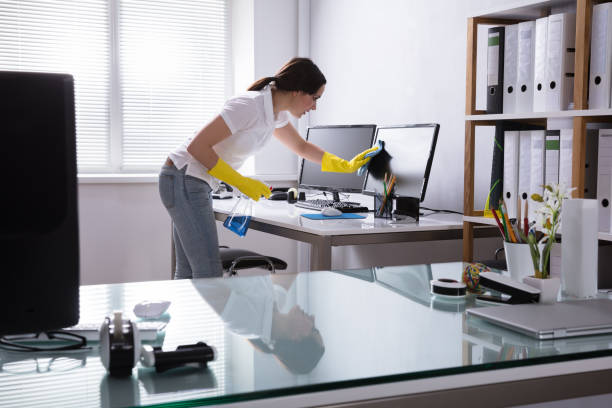It’s easy to forget how important it is to keep your workplace hygienic and tidy amid the daily craziness of work. Under the apparent dust and debris, there are unseen threats that could hurt staff health and the organization’s total output. This article delves into the imperative of deep workplace cleaning, shedding light on the often underestimated risks and emphasizing the critical need for thorough cleanliness measures.
I. The Unseen Threats
Although an initial glance could indicate that the workplace is quite hygienic, in actuality, a lot of risks are hidden from view. Microorganisms, allergies, and pollutants can gather on surfaces, in the surrounding atmosphere, and the obscure crevices of the office. These hidden dangers represent a severe risk to workers’ health and could result in higher absenteeism, lower productivity, or even long-term health problems.
II. Impact on Employee Health
A neglected office environment can become a breeding ground for bacteria and viruses, contributing to the spread of illnesses among employees. Common areas such as break rooms, restrooms, and shared workspaces are particularly susceptible to harboring germs. From the common cold to more serious infections, the health of the workforce is at stake when regular cleaning practices are not prioritized.
Furthermore, the quality of indoor air is crucial to the well-being of employees. Over time, dust mites, mold spores, and other allergens can build up and cause respiratory problems as well as aggravate pre-existing illnesses like asthma. Thorough dusting, vacuuming, and air purification are all part of a comprehensive cleaning routine that is necessary to reduce these health hazards and make the workspace safer.
III. Psychological Impact
Not only can an untidy and unclean workspace negatively impact an employee’s physical health, but it can also negatively impact their emotional health. Research indicates that having a tidy and well-organized space lowers stress levels and enhances concentration. Conversely, a chaotic and untidy workspace can lead to increased stress, anxiety, and a decline in overall job satisfaction.
Deep workplace cleaning extends beyond mere hygiene – it fosters a positive and conducive atmosphere that promotes employee engagement and creativity. When employees feel that their work environment is cared for, they are more likely to take pride in their workspace and, consequently, produce higher-quality work.
IV. Long-Term Productivity and Cost Considerations
The cost of neglecting workplace cleanliness goes beyond immediate health concerns. A spike in absenteeism due to illnesses can result in decreased productivity, missed deadlines, and a strain on the entire team. Preventable health issues can lead to increased healthcare costs and employee turnover, further impacting the organization’s bottom line.
Investing in regular deep cleaning measures is a proactive strategy that pays off in the long run. Businesses can improve productivity, eliminate sick days, and cultivate a healthier staff by limiting the accumulation of pollutants and germs. It’s an investment in the health and effectiveness of the company, not just an expense.
V. Regulatory Compliance and Reputation Management
Regulatory agencies in various industries set criteria for hygiene and cleanliness in the workplace. There may be fines, legal repercussions, and reputational harm to the business for breaking these rules. Potential workers, partners, and clients sometimes make snap judgments about a business based on its facilities. An orderly and well-kept workspace demonstrates an organization’s dedication to professionalism, worker welfare, and general excellence.
VI. Implementing a Comprehensive Cleaning Strategy
Understanding the hidden dangers of a neglected workplace is the first step, but implementing a comprehensive cleaning strategy is equally crucial. A deep cleaning regimen should encompass both regular maintenance tasks and periodic intensive cleaning efforts.
Routine Cleaning Tasks:
- Daily disinfection of high-touch surfaces such as doorknobs, light switches, and shared equipment.
- Regular vacuuming, dusting, and mopping to maintain a clean environment.
- Cleaning and sanitizing common areas, including restrooms and break rooms, on a daily basis.
- Periodic Deep Cleaning:
- Scheduled deep cleaning sessions for carpets, upholstery, and curtains.
- HVAC system cleaning and maintenance to improve indoor air quality.
- Thorough cleaning of less frequently touched surfaces, such as office furniture and fixtures.
Employee Education:
Promoting cleanliness habits among employees, such as proper hand hygiene and responsible use of shared spaces.
Encouraging the reporting of maintenance issues promptly to prevent prolonged exposure to potential hazards.
Professional Cleaning Services:
Consideration of hiring professional cleaning services for specialized tasks, ensuring a thorough and effective cleaning process.
Conclusion
The hidden dangers of an inadequately cleaned workplace are myriad, ranging from immediate health risks to long-term impacts on productivity and reputation. Acknowledging the importance of deep cleaning is the first step toward creating a safe and conducive work environment.
Cleaning should be prioritized as a crucial component of good company management, not as an optional luxury, as firms negotiate the challenges of the modern workplace. In addition to safeguarding workers’ health and wellbeing, a clean workplace fosters a healthy company culture and long-term success. It’s time for companies to realize that spending money on thorough office cleaning is an investment in their most precious resource: their workforce.










